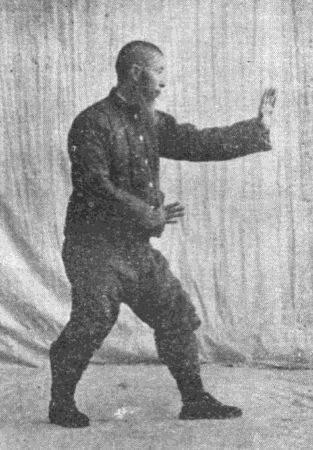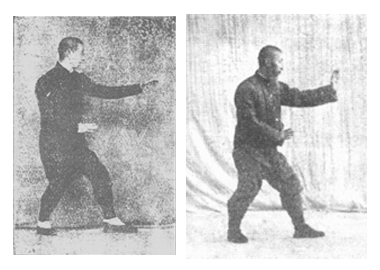Xing Yi Quan favours a fighting stance called Sān Tǐ Shì
From head to toe, you must conform to the rules of Neijiaquan.
Not much else, mainly the legs.
The legs are mainly thighs, also called thighs, including the two gluteus maximus, which are actually the hips. The crotch is connected to the lower abdomen.
Therefore, this post mainly talks about legs, hips, buttocks, and lower abdomen.
"Buttocks-lift the anus, the qi runs through the four ends, the legs are curled, the buttocks are fleshy, the lower is the qi, so it should be higher."
, "The hind foot is pushing hard, as if striding across the ditch. The fist script says: "The meaning of the foot is not lost."
Before Xingyiquan, Neijiaquan didn't have a three-sana style.
The absence of this title does not mean that there is no such momentum.
To meet the requirements of the internal body posture and rules, Shicheng must be a three-body pose.
It's just that it was extracted and refined by the ancestor of Xingyiquan.
It's a very simple momentum, and it's not easy to get it right.
The main points are: the back legs must have downward stepping strength, and the front legs must have the strength to push the knee forward.
This is done correctly. Reach out and feel the hind legs from the popliteal fossa to the gluteus maximus and lower abdomen. They should be as hard as a rock.
Did you get it right?
To put it simply, lift the front legs forward and up the knees, and stand up straight with the hind legs. At this time, feel or touch the back legs.
Keep your hind legs like this, slowly lower your front legs to the ground, hold your five toes on the ground, and top your front knees.
The front heel can be raised falsely or landed.
This is a three-body pose.

The hind legs seem to be curved but not curved, and try to straighten them, it is a chicken leg.
The front legs are not chicken legs because they are not needed.
The front legs remain virtual, and they are more flexible than both legs.
Because it is left-handed, as long as the right-handed chicken drumstick is enough.
If you make two moves, such as tiger pounce, you need to have both legs as well.
This is why when Xingyiquan is formed in three poses, there is no double disease in Taijiquan.
It should be "Because it is the left hand, as long as the right leg is a chicken leg." Cross Jin, avoid a slope.

The most important method of Xingyiquan is the three-body stance. The essentials of the various parts of the stance are set up for "yijin". The main points of the posture are:
The upper body should be upright, not leaning or tilting, and facing the front side at an angle of 45 degrees to the direction of the eye.
Head up, neck upright, face natural, buckle teeth lightly, chin slightly retracted, shoulders droop down, shoulder sockets slightly retracted; front elbows droop, do not straighten;
Head up, neck upright, face natural, buckle teeth lightly, chin slightly retracted, shoulders droop down, shoulder sockets slightly retracted; front elbows droop, do not straighten;
The index finger should be lifted upwards, the thumb should be stretched outwards as far as possible, the mouth of the tiger should be semicircular, and the palms should be closed;
Lean the forearm of the back hand on the right side of the abdomen, spread the five fingers of the hand, and collapse the wrist.
The chest is slightly inward, do not strain; stretch the ribs muscles (stretch ribs), calm and empty the heart, naturally full abdomen (sullen air), but do not deliberately bulge;
Try to stretch the back muscles to both sides (pull back); the waist should be collapsed; the buttocks should not protrude outward, and the sphincter in the anus should be contracted inward (raise the valley inside).
Shrink the hips slightly backwards (shrink the hips), buckle the knees inward slightly, and bend the front knees not to exceed the ankle joint; the hips are opposite to the back heels; the toes of the feet are buckled on the ground; the center of gravity is on the hind legs, and the front legs are weak and In fact, bear a small amount of weight;
Breathe naturally, focus on your mind, and strive for stability in your body.
After the posture is set, the whole body requires the joints to fight hard, that is, the method of "stretching the tendons and pulling the bones".
The so-called stretching of tendons and bones refers to the methods of expansion, contraction, stretching, twisting, twisting, twisting and grasping of one's own joints and joints, between parts and parts. Train yourself and the outside world in the form of contraction, grasping, stretching and stretching.
There should be a strong elastic feeling inside and outside the body. And this training method is not only in a straight line, including twisting and rotating, rolling and stretching, zooming in and out, opening and closing of throughput, and the opposite rotation of upper body and lower limbs.